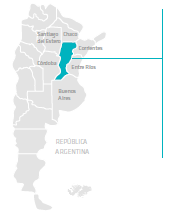The initial plan
The Plan Abre is a public policy from the Provincia of Santa Fe in Argentina. It is a very interesting urban program to think through the different understandings of sovereignty, territory and security.

Rosario is the principal city of the Provincia of Santa Fe, at the center-east of Argentina. It is the third provincial with the most population in the country. The population of the Provincia is estimated to be 3.509.113 inhabitants or a little more than 7,8% of the total population of the country (Instituto Provincial de Estadísticas y Censos – IPEC, 2019).
The Metropolitan Area of Rosario itself has an estimated population of 1.400.000 inhabitants. The city is at the heart of the biggest port complex of Argentina, from where more than 65% of cereal exports exit the country. Rosario and its metropolitan area is one of the 6 cities that were established as zones of intervention for the Plan Abre.
The analysis of the declared goals of this plan and the targeted territories is the starting point of my reflection. I want to see what vision of the intervened territories is constructed, what kind of answers are articulated and how we can interrogate them thinking through the dialectics of carceral and abolition geographies. My questions evolved with the collective process of the group, leading me to open the kind of questions while looking at very specific territorial cases.
Since our group has been trying to think through the complex and contradictory configurations between Sovereignty, Territory and Security, one of my first intention was to analyze how a program called the Plan Open was defining its territories of action, how it was framed and what actions were planned in order to “open up” those spaces. What made them seem closed? What actions were part of an opening action?
From its initial definition, the Plan Abre is “an integral strategy of intervention sustained on the coordination of different areas of the Social Cabinet of the Provincia de Santa Fe and local governments, with the purpose of recreating social links in neighborhoods (barrios) of Santa Fe, Rosario and Villa Gobernador Galvez”[1]. What is interesting here is that the idea of opening up is directly linked to “opening up” barrios (as opposed to central areas, the terms generally carries a peripherical/marginal imaginary in Argentina) to regain social links – as if social links were absent of those “closed” barrios. Those barrios are also targeted as part of three of the major cities of the Provincia, Rosario, Santa Fe and Villa Gobernador Galvez, excluding rural areas. Thus the core statement of the program targets specifically certain spaces considered to be peripheral, to reintroduce social interactions creating a narrative of closed space deprived of social interactions. This foundational mission already frames the question of openness in a certain way. Indeed many gated communities exist within the Provincia of Santa Fe, where private gated communities have flourished since the 90’s, mainly in suburban areas around Santa Fe and Rosario. One of their characteristic is that they are surrounded by walls or fences and have a restricted access, they are also often situated close to “villas” or precarious settlements (Daverio, 2020). These real estate projects are not ate the center of my interest in this work, nevertheless I think it is important to question the name and goals o the Plan Abre, knowing that it targets spaces of life considered to be in need of openness while these territories coexist -sometimes contiguously) with other territories that are actually physically enclosed.
What are the territories that have been targeted by the Plan Abre? What kind of intervention have been planned in those spaces? Who defined the nature of the needs and the kind of policies to be implemented? Why were they considered as closed and how did they get open? What reactions did these interventions spark? Who benefits from this specific kind of openness?
Through this reflection about openness, I would like to interrogate the notions of territory, sovereignty and security grounding the provincial and municipal interventions in those specific neighborhoods. I will focus more specifically on the interventions within the city of Rosario where 35 neighborhoods have been included in the program, corresponding to approximately 25,3% of the population (Langou and Aquilino, 2019).
[1] “El Plan Abre propone una estrategia de intervención integral sustentada en la coordinación entre diversas áreas que conforman el Gabinete Social de la provincia de Santa Fe y gobiernos locales, con el fin de recuperar vínculos sociales en barrios de Santa Fe, Rosario y Villa Gobernador Gálvez.” (Langou and Aquilino, Integralidad, territorio and politicas sociales urbanas, Santa Fe, 2019)


